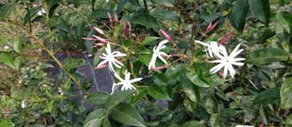
V. Baskaran*, K. Abirami and Augustine B. Jerard, ICAR-Central Island Agricultural Research Institute (CIARI).
Flowers form an integral part of almost all religious, social and cultural activities of Indian society. Both traditional and cut flowers have huge demand in commercial floriculture industry. The Andaman and Nicobar Islands demands the use of loose flowers like marigold, Jasmine, crossandra and chrysanthemum throughout the year. Jasmine is one of the most significant loose flowers as they are highly preferred in religious and social functions. Jasmine flowers are used for various purposes like garlands, adorning hair of women, religious offerings and for concrete extraction. The essential oil of jasmine is highly preferred in perfumery and cosmetic industries. Jasmine flowers are also used in aromatherapy as the fragrance from flowers is effective in treating depression, nervous exhaustion and stress related conditions. There are about 42 species of Jasmine reported in Indian sub-continent. However only three species, J.sambac, J.grandiflorum and J auriculatum are cultivated for commercial exploitation. But one of the serious limiting factors which affects both jasmine flower growers and the consumers, is that the flowering of all the Jasminum sp is seasonal. There are peak and lean productive seasons with consequent gluts and scarcity which affect the price trends greatly. To overcome the scarcity of flower availability of Jasmine during particular months of a year, a new species called Jasminum nitidumis identified which produces flowering throughout the year in different agro-climatic regions of the country. In Andaman and Nicobar Islands, J, sambac is grown mostly and flowering is observed only for two months in a year due to the prevailing climatic condition. The existing demand for jasmine is mainly met by the import of flowers from mainland. An alternative to this is the identified underexploited jasmine species which is commonly known as star jasmine or shiny jasmine (Jasminum nitidum). The origin of this species is Admiralty Islands of Papua New Guinea. Since the geographical origin of the species is from Island, this is well adapted to grow in Andaman and Nicobar Islands. The three-year evaluation trial conducted at ICAR-CIARI showed good performance of star jasmine and flowering was observed for almost 10 months in a year.The plants, have long woody stem and bold buds. Leaves are smooth, leathery, simple (not divided), lanceolate (broad at center) with opposite arrangement and dark glossy green which in addition makes the plant attractive. The buds are tubular shaped at both the ends and resembles the species, Jasminum grandiflorum. The flowers are very attractive, mild fragrant and produced in clusters. The flower buds are dark purplish in colour when immature and the colour is changed to pinkish purple as they mature. Opened flowers are snow white and star shaped flower with 10 petals which are leaner, longer and spread out. Open sunny situation is best for cultivation of this flower crop for quality flower production. This crop can be grown in open field and also in pots. The spacing to be adopted is 75 cm between plants and 1.0 m between rows.The plant is propagated through air layering and cuttings. Air layering done during June to October gave maximum success percentage of 80-90%. For propagation through cuttings, semi hard wood cuttings of size 15-20 cm are planted in polybags filled with potting media. After 45-60 days of planting the rooted cuttings may be planted in pots or in main field. Though J.nitidum can be propagated throughout the year using cuttings, success percentage (92-95%) is maximum during June -November months. After planting in main field life irrigation is to be given for initial establishment of the crop. Irrigation is not required during rainy season, however during prolonged dry period, weekly irrigation is essential. Flower buds will initiate six months after planting, however, the economic yield will be obtained from second year onwards. During initial period of crop establishment proper training is needed to maintain the plant as a shrub. Good quality FYM or compost can be applied @ 5 kg per plant per year in two splits, one before monsoon and one after monsoon (In December, one week after light pruning of the plant). Flowers are borne in new flush of shoots. In a cyme, 08-14 flowers are observed. The yield per plant is 2 -2.5 Kg per plant (two years after planting). Heavy bloom is produced during summer in Island conditions. The flowers bloom at night. The harvesting stage is the matured bold bud stage with pink tinge. The buds arebold and easy to pluck, with its long corolla tube. Due to the length of the corolla, it is easier to string the flowers for various value-added utilities. The flowers will not droop for four to five hours. Under refrigerated condition, the flowers can be stored for 2 to 2.5 days. Jasminum nitidum is a versatile crop with wide commercial utilities and hence will be one of the potential crop to exploit in the Island. The star jasmine can be cultivated for aesthetic purpose in pots for home gardens and also to develop as a commercial venture with planting in large field area. *Corresponding author’s E mail: vbaski01@gmail.com